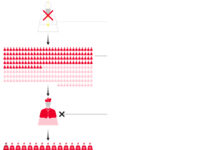David Bohnett was born 13 years before the Stonewall Revolution, which kicked off the modern day gay civil rights movement in 1969 – and his early life tragically mirrored the struggle. His first lover took his own life because he couldn’t reconcile his religion and his sexuality; he was in the closet with his family until 1983; his life partner died of AIDs in 1993; and he had to wait another 22 years before same-sex marriage was legalized across the United States.
But while that would be enough trauma to stop most people in their tracks, Bohnett took those experiences and created an entire world where people could not only connect over similar interests, but also live as the people they truly were.
Bohnett’s life partner — Rand Schrader, who was the first openly gay staffer in the Los Angeles City Attorney’s Office and, later, one of the few openly gay judges in the entire world — left him a sizable amount of money in his life insurance policy after he died from complications due to AIDs. Bohnett took that money and co-founded an internet service provider (ISP) he named Beverly Hills Internet in 1994.
As a marketing gimmick, he and his co-founder, John Rezner, also installed web-connected cameras at the corner of Hollywood and Vine, right near the Hollywood Walk of Fame. Anyone with access to the web could log on to their company’s site to see what was going on in the heart of Hollywood via an image that reloaded every six to eight seconds.
While that doesn’t sound like much in an age when virtually everyone carries a super computer in their pocket, in 1994 it was revolutionary. This was before webcams even existed; Rezner and Bohnett also welded cameras to their monitors to create their own DIY webcams. So being able to watch what was happening, in real life, in real time, was a big draw for the company.
But Bohnett wanted Beverly Hills Internet to be more than just another ISP with a gimmick. He started thinking: What if this new version of the web could be something totally different? What if, instead of information, the world wide web could be about habitation?
What Bohnett was hitting on was the idea of the internet as a place, similar to a physical one, where people would choose to spend time, socialize, and hang out. It wasn’t a completely novel idea — AOL started mailing compact discs (CDs) direct to American homes in 1993 with a similar model, centered around chat rooms — but Beverly Hills Internet was the first company to offer internet “spaces” — aka home pages — to the average consumer, for free.
The company started offering a free plan complete with 2MB of storage space in June of 1995, which was also the time that this idea of the internet as a place started to expand. Rather than simply offering people the ability to create their own homepages, Bohnett decided to organize them into thematic “neighborhoods.”
The first neighborhoods were modeled after real places — Hollywood, for entertainment; WestHollywood, for gay and lesbian communities; RodeoDrive, for shopping; SunsetStrip, for music; and WallStreet, for business — which allowed customers to jump directly into communities of people with similar interests. “Homesteaders” would pick an address in a virtual neighborhood that matched their interests, build their homepage with no knowledge of HTML, and start connecting with other people in their “neighborhoods.”
The idea took off — and Bohnett renamed the company GeoCities.
The fact that one of the original five GeoCities neighborhoods was named after West Hollywood, one of the major gay meccas of the world, wasn’t an accident.
“I think a lot of that comes from my own experiences as a gay man and coming out and meeting other lesbian and gay people and understanding the power of meeting others of your own identity,” Bohnett said about the founding of GeoCities on the 99% Invisible Podcast.
While we remember GeoCities today primarily as a kitschy artifact from the weird and wild early days of the web, many of the seeds of what would become essential to the modern day internet sprouted there. GeoCities created places where humans could connect with each other through their creativity; a thread that can be seen through all the big social media sites that followed, from MySpace to TikTok. It sucked users in with a free product (hello, Instagram) and then monetized it with advertising (hello again, Instagram).
Perhaps most importantly, it recognized that human beings don’t do well with a concept so vast and abstract as the digital world. To handle that problem, it created a metaphor based on one of the most essential elements of humanity: The way we organize into groups via towns and neighborhoods.
And the idea of the internet as a place has never been more relevant than it is today. We “hang out” on social media sites. We date on apps. We work on Slack and Zoom and Google. And, since the pandemic, we spend even more of our time “in” digital spaces: In March of 2021, one year into the pandemic, nearly three in 10 American adults told Pew Research that they were “almost constantly” online.
So the fact that GeoCities was created by a gay man, a person who had to struggle through so much of life simply because of who he loves, is not a footnote. It’s a headline. And it’s one more piece of evidence that peoples’ deep need for identity, community, and connection can lead to truly incredible things.
*** This is a Security Bloggers Network syndicated blog from blog.avast.com EN authored by Avast Blog. Read the original post at: https://blog.avast.com/gay-history-modern-internet









